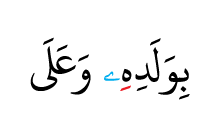Rules of Madd
Madd means to stretch or prolong a sound.
In Tajweed, it refers to making certain letters longer than usual, but only under special conditions. There are three madd letters which are Alif ( ا ), Yaa ( ى ) and Waaw ( و ).
You’ll often see these letters in the Quran without a Fatha, Dhamma or Kasra.
When any of these letters have no Haraka, they are now Madd letters that prolong sounds. There are two different types of Madd in the Quran; Natural Madd and Secondary Madd.
What is a Saakin Letter ?
A letter with sukoon or a letter without any Haraka is called a Sakinah letter. For example: Alif sakinah refers to the letter Alif with sukoon or an Alif without Haraka.
Tajweed
The Quran was revealed by Angel Jibreel to Prophet Muhammad (pbuh) by the will of Allah with the rules of Tajweed applied to it. The rules of Tajweed show us how to read the Qur’an just like Prophet Muhammad (pbuh) did when he learned from Jibreel. Learning Tajweed prevents us from making pronunciation mistakes and changing the meaning of the words as we recite. That’s why when we recite we must give each letter in the Quran its rights and dues. This is how the message of Allah is delivered with its correct meanings.
Natural Madd
If There Is a Fatha Before an Alif ( ا )
If an Alif ( ا ) with no Haraka (Alif Sakinah) comes after a letter that has a Fatha, then the sound will be prolonged for two counts (two Harakat), which is equal to the time it takes to say “one-two”. Let’s say one second for it.
An Alif ( ا ) can also be written as a small ( ) sign in between the letters. When this happens, the same rule applies and the sound will be prolonged for two counts.










































If There Is a Kasra Before a Yaa ( ى )
If a Yaa ( ى ) with no Haraka (Yaa Sakinah) comes after a letter that has a Kasra ( ِ ), then the sound will be prolonged for two counts.
























Similar to the rule above, the Yaa Sakinah can sometimes be written in a smaller ( ى ) and a separate sign between two words.
This Madd will be pronounced only if you continue reading. When it occurs, the sound will be prolonged for two counts.
If you stop at the first word, don’t pronounce the Madd letter.
If There Is a Dhamma ( و ) Before a Waaw
If a Waaw ( و ), with no haraka (Waaw Sakinah) comes after a letter that has a Dhamma ( ُ ), then the sound will be prolonged for two counts.
























Similar to the rule above, the Waaw Sakinah can sometimes be written as a smaller and a separate ( و ) sign between two words.
This Madd will be pronounced only if you continue reading. When it occurs, the sound will be prolonged for two counts.
If you stop at the first word, don’t pronounce the Madd letter.













